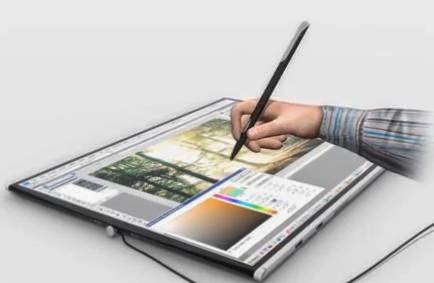Its so boring to handle
the heavy laptops…from one place to another with quite difficulty. But with the rising era the Germany's Orkin Design proposes
rolling up both devices into one ultra-portable package.
Introduction:
Let us
get introduced with the new latest technology which is ROLLTOP TECHNOLOGY. Notebooks and tablets
already offer pretty convenient computing on-the-go solutions. The Rolltop concept will take advantage of
advances in flexible OLED and touchscreen technologies to create a
cylinder-shaped laptop computer that can be rolled out to form a notebook, a
tablet, or display monitor. Besides leading to an extreme the concept of portable computer, the rolltop succeded in
reuniting two of the largest consumer dreams of geek on calls: netbooks ,
objects of desire of any user who want to stay connected and up to date with
new technology and tablets, even more famous after rumors of the launch of
Apple Tablet.
Rather than carry
around a notebook in a laptop bag, full to the brim with all manner of cables,
the Rolltop concept proposes bringing everything together in a flat panel
display that's wrapped around a central cylinder. The top of the column
detaches and acts as a power plug while the carry strap doubles as a power cord
(presumably some sort of battery technology is also included, although this has
not been mentioned). The central column also contains speakers, a camera, USB
ports, and a LAN port.
The main goal of this
technology is to combine the laptop, monitor and the graphic tablet into
one gadget and avoid additional
accessories. The Rolltop does not have a CD/DVD reader or floppy disc because
they are obsolete.
After unlocking the
catch, the user would roll out the Rolltop display like a mat and then either
leave it flat for 17-inch tablet computing, or raise one end up for something
resembling a notebook. The lower part of the screen is then used for keying on
a virtual, onscreen keyboard while the upper part becomes a 13-inch display for
viewing content. A pull-out support at the back also allows the flattened
device to be used as a monitor-like display, and a stylus pen has been
incorporated into the body of the panel. To close the package dream of
consumption, it also lets us to view videos, or photos like a portable
television. The screen has a support on the back. With this you can leave it
up, and watch a movie while waiting for the email from your boss.
When rolled up, Rolltop
will be 11 inches (28 cm) long and have a 3.26-inch (8.3-cm) diameter – and
that's about all we can tell you. As it's a concept designed to be built in the
future, some of the technology kinks are still being worked on, but Orkin has
stated its intention to see this design through to an actual, real-world
product. There are, of course, quite a number of technical hurdles to overcome
before that happens and unfortunately the designers do little to shed light on
how such difficulties will be dealt with, leaving us to speculate.
Future
scope:
It requires no great
stretch of the imagination to visualize the various technologies already used
in dual-screen notebooks, all-in-one computers and cutting edge tablets being
incorporated into the Rolltop. However, details on how the internal components
like processors, memory, storage and graphics cards will be dealt with have not
been forthcoming, so it looks like we're just going to have to wait until there
is more substance to this project .So we can say that the Rolltop technology is
a great boon to the present as well as the coming generation and may be in
future it the recent developments in bendy screen technology might also make
this device a current possibility.














